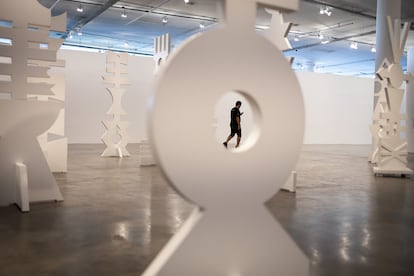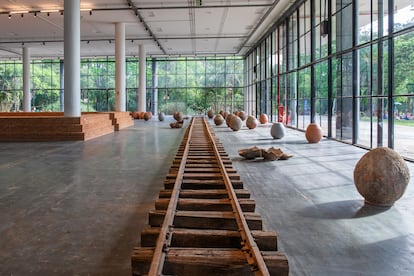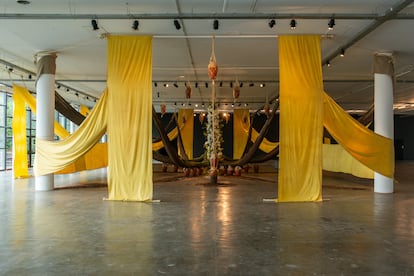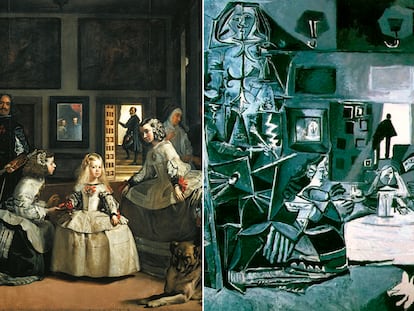The São Paulo Biennial responds to ‘the new fascisms’ with 80% non-white artists
The largest artistic event in the southern hemisphere opened its 35th edition, which tells an alternate history of the art of the 20th and 21st centuries

The São Paulo Biennial, the most important event for contemporary art in the Southern Hemisphere — and the second oldest in the world, after the Venice Biennale — has opened its 35th edition, marked by an unprecedented presence of artists from the global south, with an 80% of non-white participants out of a total of 121. The exhibition, titled Choreographies of the impossible, is political and poetic, brave and emphatic, heterogeneous and irregular, discursive but also sensual, a journey that serves as an alternate history of the art of the 20th and 21st centuries, paying less attention to Western hegemony and more to the wisdom of underappreciated traditions, such as the Indigenous cultures and the African diaspora in Latin America, in addition to the Arab world and the Asian continent.
The exhibition aims to overrule the hierarchies that were imposed with the transition to modernity, in light of the capitalist colonial project. The new edition of the biennial, which can be visited until December 10 at Ibirapuera Park — an emblem of rationalist purism projected by architect Oscar Niemeyer — is directed by a diverse team: curator Diane Lima, anthropologist and art researcher Hélio Menezes (both Brazilians) and the Portuguese artist and theorist Grada Kilomba, all three of African descent; with them is Spanish Manuel Borja-Villel in his first project since he left the management of the Reina Sofía Museum in January.
“This biennial offers a response, from art, to the new fascisms, which are different from those of the 1930s,” Borja-Villel stated on Monday. “The extreme right still clings to God, family and homeland, but now it’s not a dictator with a loudspeaker, but entire groups. The voices have multiplied thanks to the new technologies, and that makes it more difficult to respond to their lies. That’s why a large part of the left is disoriented,” adds the former director of the Reina Sofía, who in this biennial puts into practice some of the theoretical concepts that he introduced in that institution, such as the question of decolonization and the critical analysis of the Enlightenment principles.

The result is similar to other recent attempts to establish a counter-narrative of art history, such as the latest Documenta or the 2022 Venice Biennale. “Our work does not aspire to create a counter-image, but to abandon the discourses that have been imposed on us as universal narratives,” explained Kilomba. A clean slate is not possible, but ignoring that hegemonic model seems desirable when it is time to create other worldviews. For example, the biennial opposes the Western conception of time as a straight line that advances towards a supposedly better future, substituted here by the temporality of native peoples. “We have selected artists, collectives and social movements who understand time as a spiral, who believe in recurrences and who break with the idea of the past, present and future as if they were hermetic categories,” explains Menezes. The setting itself reflects that idea: it is an immense open space where one can wander, with no defined sections or literal themes, guided by “an enigma,” in the words of Borja-Villel.
At the beginning of the exhibition there is an installation titled Parliament of Ghosts, by Ghanaian Ibrahim Mahama, that presents an empty brick square next to an abandoned railway, close to another work by Brazilian Ana Pi in which revolving metal blades penetrate some reddish earth; two metaphors of Western extractivism in which the silence of the oppressed seems to reign. Not far from there, a mix between Darth Vader and Mickey Mouse is poised for cutting logs with a chainsaw in a monumental installation that recreates a glade. Its name is Killing us Softly, by Filipino artist Kidlat Tahimik, who is determined to denounce “the genocide of the forests” and the harmful potential of the American cultural imperialism. “We are tired of their stories, their songs and their superheroes,” said Tahimik, standing next to his work. At its side, the Guatemalan Marilyn Boror Bor presented the pedestal of an absent sculpture, without a heroic figure crowning the ensemble, which the artist dedicated to “the freedom of rivers, lakes, hills, mountains and flowers.”
Far from only analyzing the present, as many contemporary biennials do, this one also scours the past in search of some tutelary figures that promoted this vindication of the excluded and defended mutant identities, such as Cuban Wifredo Lam, African-American Charles White or Franco-Antillean filmmaker Sarah Maldoror, a pioneer of Pan-Africanism. Going even further into the past, Borja-Villel obtained the supposedly impossible loan of an invaluable series of 116 Bolivian watercolors from the 19th century, the work of Melchor María Mercado, which subvert and satirize the colonial order and even contemplate an “upside-down world” where an ox uses two men, in a quasi-sodomistic position, to plow a field.
The Cabello/Carceller duo reminds us that gender dissent is not strictly a recent matter through the story of Catalina de Erauso, the lieutenant nun who took part in the Conquest with a papal bull that allowed her to dress as a man. Another duo, Patricia Gómez and María Jesús González, presents a long series of graffiti that was transferred from the walls of prisons and psychiatric hospitals to the walls of the museum, albeit with no intention to take up the discourses on naïve art that used to be so popular in the world of art until not so long ago.

On the third floor, a series of pagan altars and mutant totems, as if adulterated by colonization, reflect the hybrid nature of contemporary identity in the works of Latin American artists such as Elda Cerrato, Rubem Valentim, Guadalupe Maravilla or Daniel Lind-Ramos. Benvenuto Chavajay stages atavistic rituals in current contexts, as if reaffirming their usefulness and validity in the present, in a fantasy example that ethnography would surely reject as unscientific. A similar role is played by the Yanomami filmmakers, who capture the dreams of the members of this Amazonian people in a series of videos that oscillate between the anthropological document and the poetic license.
The biennial is also committed to rereading the archives, as they tend to “condemn the losers to always be losers,” says Borja-Villel. A photographic collection about Argentine transgender individuals shows that they were not only victims of violent oppression; they were also beings who desired and were desired. Rosa Gauditano’s work documents the lives of lesbians in São Paulo, who in addition to being ostracized are also excellent pool players, while Zumví Arquivo Afro Fotográfico shows the lives of the members of the working class in Salvador de Bahía, more complex than what the media shows: the nuns demonstrate, the poor have fun and the carnival is a political celebration.

Between dissident cosmogonies and large-format installations created with natural materials such as textiles, terracotta and turmeric in the work of Daniel Lie, one can find the restaurant of the biennial, run by the Movimento Sem Teto do Centro, which fights for the right to decent housing in the city. It only serves organic and ethically produced food, “against the chemicals that slowly poison us,” Menezes states. Over the tables, a series of colored banners display slogans such as “Domestic is political” or “Ask the soil and the roots.”
Sign up for our weekly newsletter to get more English-language news coverage from EL PAÍS USA Edition
Tu suscripción se está usando en otro dispositivo
¿Quieres añadir otro usuario a tu suscripción?
Si continúas leyendo en este dispositivo, no se podrá leer en el otro.
FlechaTu suscripción se está usando en otro dispositivo y solo puedes acceder a EL PAÍS desde un dispositivo a la vez.
Si quieres compartir tu cuenta, cambia tu suscripción a la modalidad Premium, así podrás añadir otro usuario. Cada uno accederá con su propia cuenta de email, lo que os permitirá personalizar vuestra experiencia en EL PAÍS.
¿Tienes una suscripción de empresa? Accede aquí para contratar más cuentas.
En el caso de no saber quién está usando tu cuenta, te recomendamos cambiar tu contraseña aquí.
Si decides continuar compartiendo tu cuenta, este mensaje se mostrará en tu dispositivo y en el de la otra persona que está usando tu cuenta de forma indefinida, afectando a tu experiencia de lectura. Puedes consultar aquí los términos y condiciones de la suscripción digital.
More information
Archived In
Últimas noticias
Iranian women are also defying the taboo of riding motorcycles (and without a license)
David Bowie, the galactic thinker who encouraged us to break new ground
John Berger and the loss of rural culture
From police officer to bloodthirsty kidnapper: Terror in Mexico during the years of ‘The Ear Chopper’
Most viewed
- David King, chemist: ‘There are scientists studying how to cool the planet; nobody should stop these experiments from happening’
- Reinhard Genzel, Nobel laureate in physics: ‘One-minute videos will never give you the truth’
- Oona Chaplin: ‘I told James Cameron that I was living in a treehouse and starting a permaculture project with a friend’
- Mexico completes its trade shift with the entry into force of tariffs on China and countries without trade agreements
- Sinaloa Cartel war is taking its toll on Los Chapitos











































